
I’ve yet to see a garden that doesn’t have at least a few planted containers included in its design.
Whether artfully placed near the front door, grouped on the back patio, or perhaps incorporated into a garden bed, containers are beloved by gardeners everywhere.
When I plant containers in my own garden, they’re often serving double-duty. They not only look beautiful, but they’re serving as a solution to a garden problem (ie: covering an eyesore, enhancing a garden’s design, or filling in gaps in the garden.)
So, today I want to share with you some of my favorite strategies I use when incorporating containers in my garden.
1. Year-round focal point containers…placed IN the garden bed
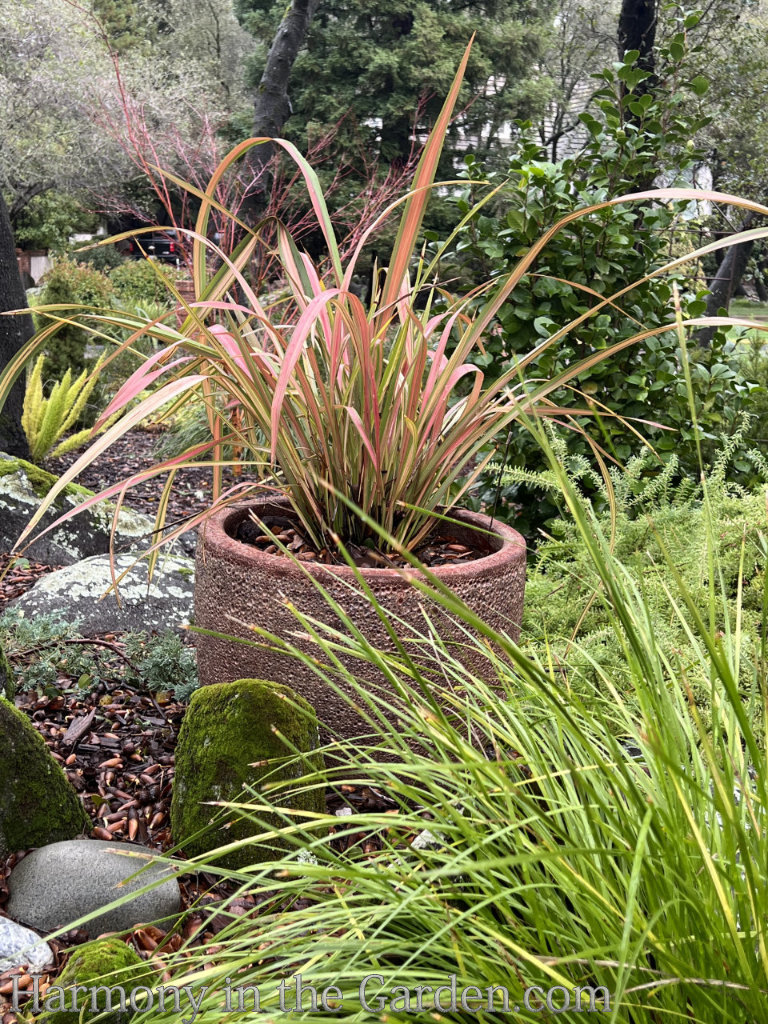
Planting a container with year-round plants not only ensures the container will look good for a long time but also reduces the amount of work I need to do!
I simply don’t have time to continually replant containers with seasonal combinations. Therefore, year-round plants are my #1 choice in containers.
And when placing these containers, I love to set them within the garden bed.
A lot of people are surprised by this, but think about it – why not? Who says containers need to only live on patios or decks?
Provided you elevate them a bit to prevent blocked drainage holes (using pot feet or even bits of broken brick), placing them within a garden bed creates a bit of drama.
The container stops the eye, commands attention, and adds another dimension (or layer) to the garden bed.

My daughter helped pick out this container a few years ago, loving how it looked like an artichoke.
She wanted to make sure the plants we used looked like an artichoke, so we planted an agave desmetiana ‘Variegata’ in the center.
To resemble the purple flowers of an artichoke plant, we placed a dwarf aster ‘Barbados’ behind the agave. Cascading down the sides is sedum ‘Angelina.’
While the aster is deciduous, the agave and sedum are evergreen which ensures the container looks good year-round.


Here again, I’ve placed a container of agapanthus ‘Summer Sky’ and sedum pachyphyllum within a garden bed.
In fact, if you look closely you’ll see that I’ve also planted the sedum pachyphyllum at the base of the container to look as if it’s spilling over.
I often use this ‘spilling over’ strategy to help the container tie in with the surrounding garden.

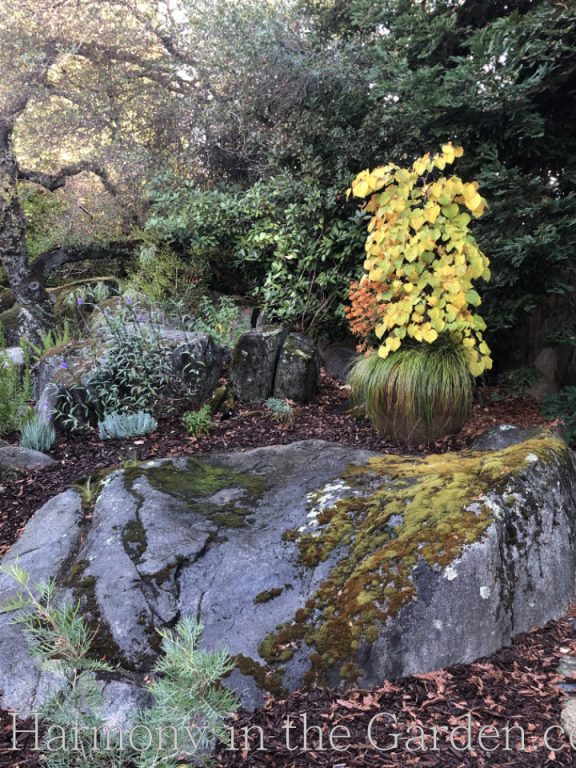
Even though I recently wrote about my fabulous weeping cercis ‘Ruby Falls’ I’m including it here again to demonstrate how I’ve placed the container within the garden bed.
If you missed my last article, click here to see more pics.
2. Add a bit of drama to a small space
Sometimes it’s challenging to add interest to really small or narrow garden beds. A container can be the solution, not only adding height (which can be difficult to attain in a small and narrow bed) but excitement, as well.

I’ve previously written about the skinny, moon-shaped bed underneath my carport (click here for more pics), but the star of the bed is this container.
It’s a scorching hot area, so whatever lived in the container would have to be super tough.
The Australian Wooly Bush (adenanthos sericeus) is perfect, and thrives with blistering heat and little water.
The lipstick-red blooms of the crocosmia ‘Lucifer’ not only adds a pop of color but attracts every hummingbird in the neighborhood.
If that isn’t drama, I don’t know what is!!


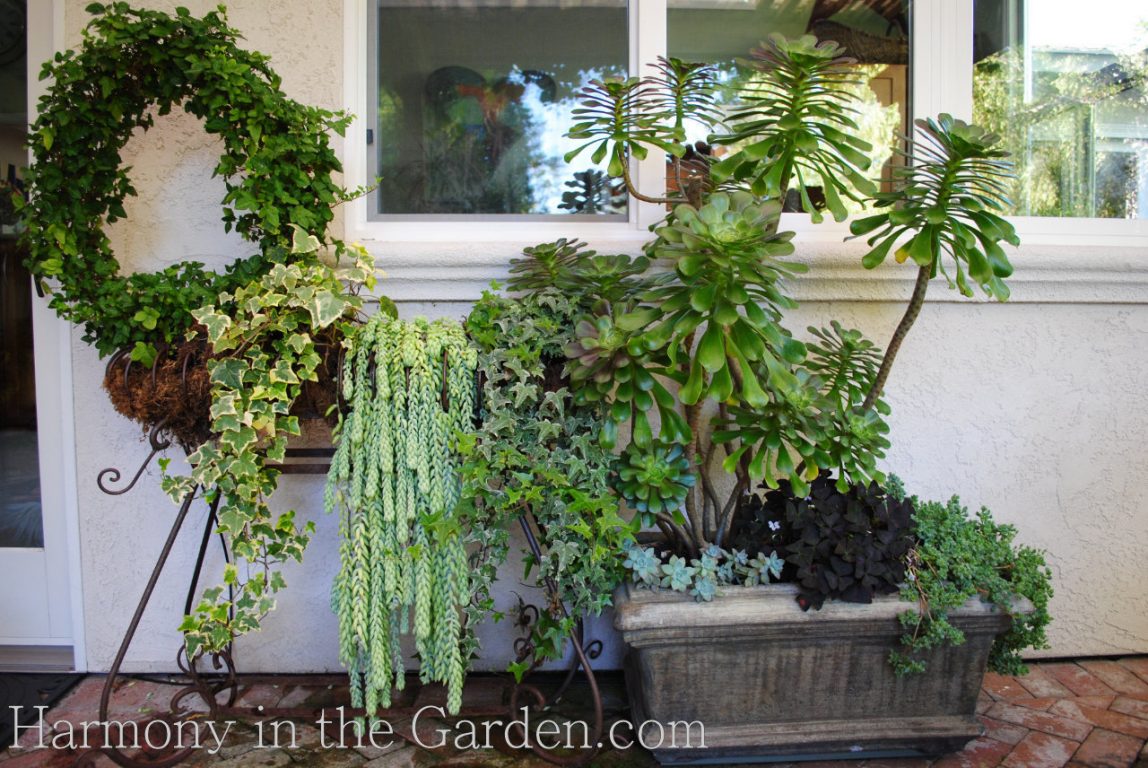
Patios can be notoriously tight on space, making rectangular shaped containers the perfect choice.
In this photo, I used two containers (one placed on the ground and the other elevated) to not only soften a boring stucco wall but to add varying heights.

Succulents are ideal for planting in notoriously tight spaces, thanks to their shallow roots and their ability to withstand infrequent watering.
Fussier plants would wilt without constant attention – but not succulents!
In this photo, I’ve used them to add year-round interest high up on a small ledge (perfect for greeting guests!)


…or sitting on the narrow end of my stone bench.
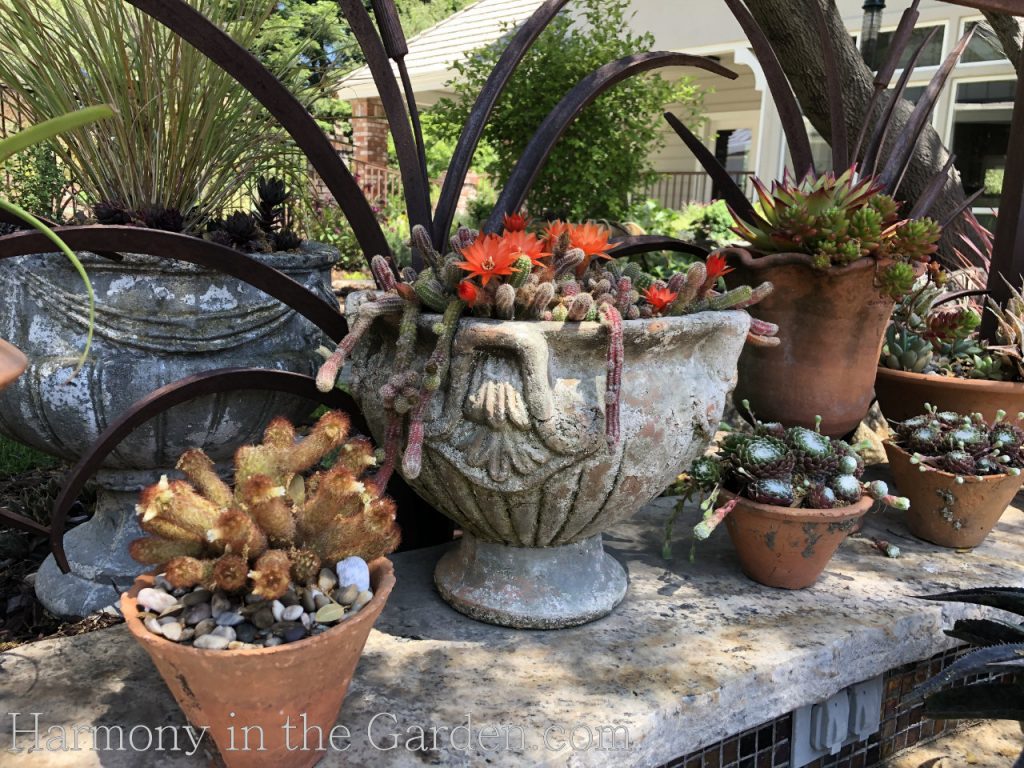
A skinny 7” ledge runs along the back of our outdoor BBQ, making it the perfect shelf for my collection of succulents.
To prevent things from looking too chaotic, I stick to a simple palette of container colors.
I primarily use terra cotta containers (my favorites are from Campo di Fiori and Guy Wolff), or those in light or dark gray.
3. Hide a garden eyesore
I’ve never seen a garden that doesn’t have at least one eyesore that the homeowner would love to see disappear. Luckily, plants can often come to the rescue!
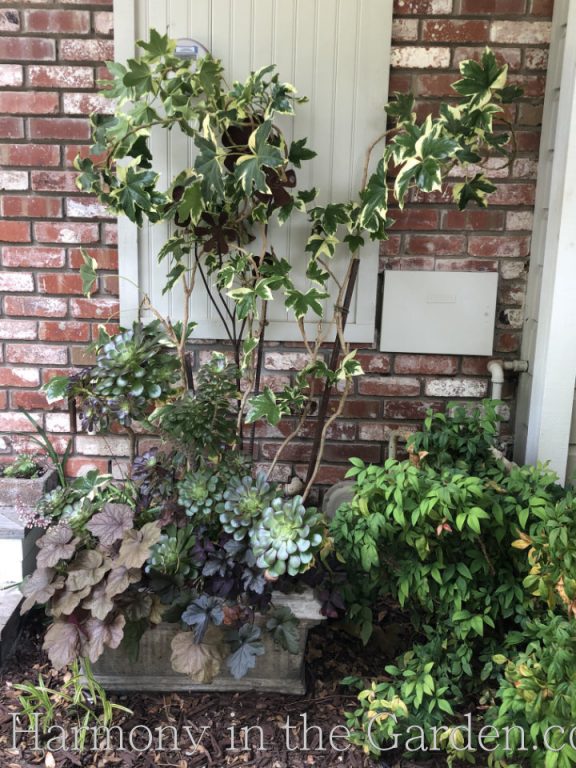
There’s an area under my carport that is truly awful with one eyesore after another. An electric meter, a gas meter, and an electrical panel mounted on the wall.
We had a nice ‘frame’ of sorts built to hide a lot of the electrical panel, but it still wasn’t enough. That’s where my containers come in!
The tall, evergreen fatshedera ’Angyo Star’ provides the height I needed to cover the wall unit.
And because it grows quickly, and isn’t invasive in the least (despite having ivy in its lineage!), I never have to worry about it attaching itself (and causing destruction) to my walls.


The ‘Toyosho’ ornamental pomegranate is another favorite I hauled with me from my last garden.
It’s the centerpiece of this container, which conveniently blocks the unsightly side of our outdoor BBQ.
While it isn’t evergreen, it’s worth its weight in gold with fabulous (and long-blooming) double, peach flowers!
Plus, it turns a vibrant yellow in the fall for an additional seasonal show.

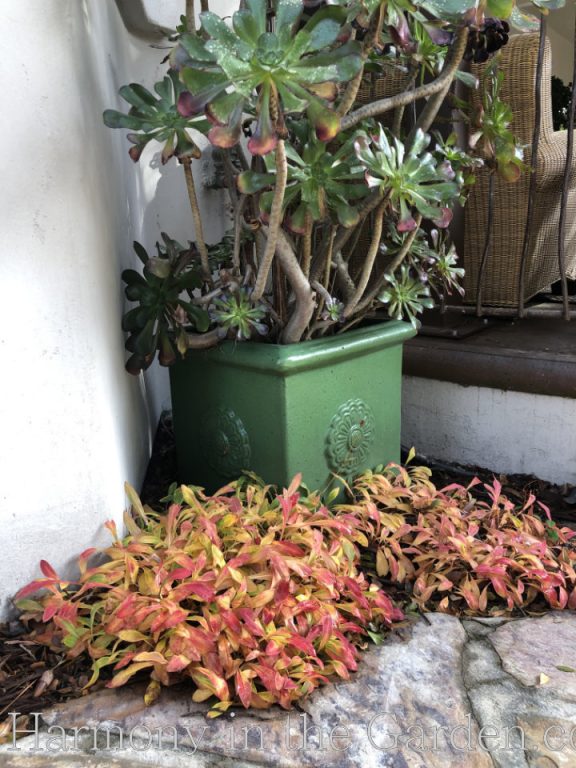
A cluster of unsightly irrigation valves (covered with globs of stucco from a remodel, which despite my best efforts, just won’t come off) is discreetly hidden behind this strategically placed green container.
More of my favorite aeoniums live here, requiring nothing but an occasional drink of water during hot weather.
At the base of the container is persicaria ‘Border Jewels’
4. Fill in the gaps during a garden’s down-time
Sometimes a container is the perfect thing to bring a bit of beauty to your garden during it’s down-time.
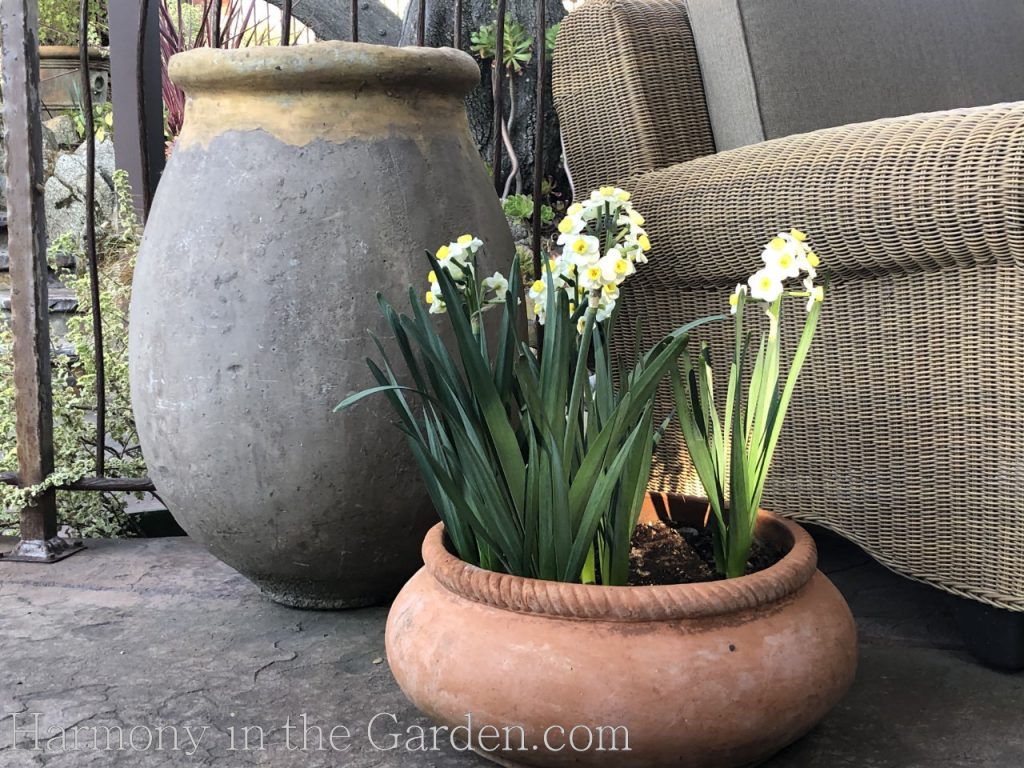
Bulbs are a natural for this purpose!
During the late winter months, when not much is blooming, I like to bring pots of bulbs on my patio where I can see them from inside my home.
I love heirloom bulbs (these are ‘Avalanche’ from Old House Gardens) and even before they bloom, their slender green leaves fill me with so much happiness during the gloomy months of February and March.
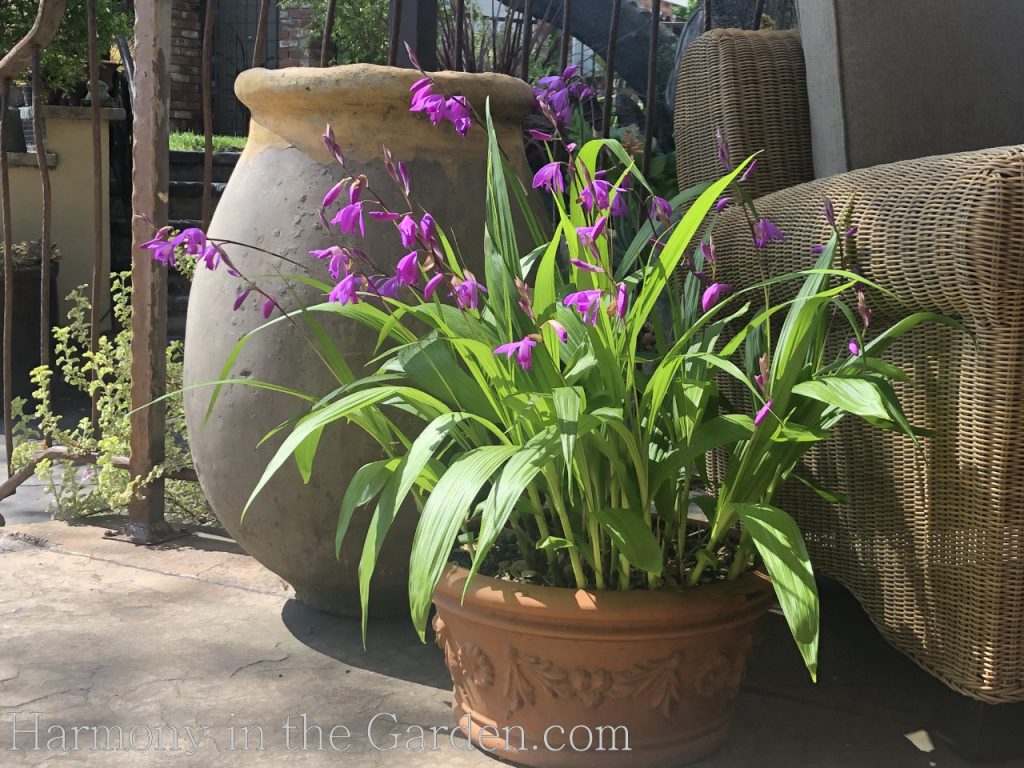
After the bulbs are finished blooming, the Ground Orchid takes its turn on stage.
These have lived in this container for several years, having first started as a tiny slip given to me by a fellow gardener.
They seem to love being crowded because they are jam-packed in there and keep kicking out the blooms!

Another container lives on my patio (in full view from my kitchen windows), and I like to plant it with lettuce or kale during the winter months, snuggled next to the year-round carex.
After the kale has disappeared, I’ll pop in a coleus to keep the carex company until winter arrives.
Then it’s back to kale again.
5. And finally – containers are a great way to showcase your humor and creativity!
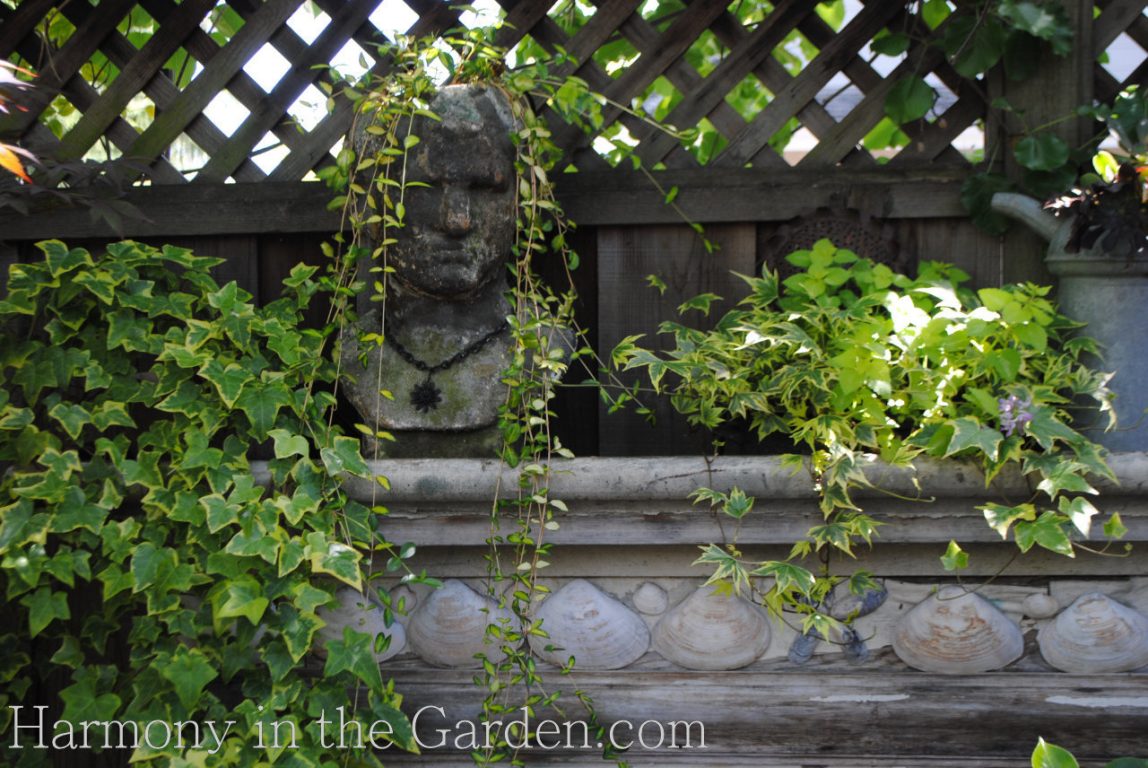
The fireplace mantle from my last garden (click here to read how I rescued it from a dumpster) was the perfect vehicle for my old, beloved head container.
While I didn’t take the mantle with me, I DID take the head!

Now he lives on the ledge of my outdoor BBQ, with a sunburned aloe for his hair.

In the far left corner of the above photo is a giant clam shell (a gift from my uncle), filled with succulent cuttings.
Of course I had to take it with me!

Most anything can be transformed into a container with a little hard work and some creativity.
My planted chair was one of my favorite additions to my garden (click here to watch a video of how I created it.)
A few things to remember when planting containers:

Underplantings
Something I’ve noticed is that some gardeners don’t take full advantage of the entire container. I’m referring to the layer at the very top of the soil, which is ripe for planting low-growing plants (something I call ‘underplantings‘.)
If a container is packed full with several low growing plants, this may not be an concern.
However, if a container’s main star is a deciduous one (such as my ‘Toyosho’ pomegranate, above) adding evergreen underplantings are a great way to add another layer of interest.
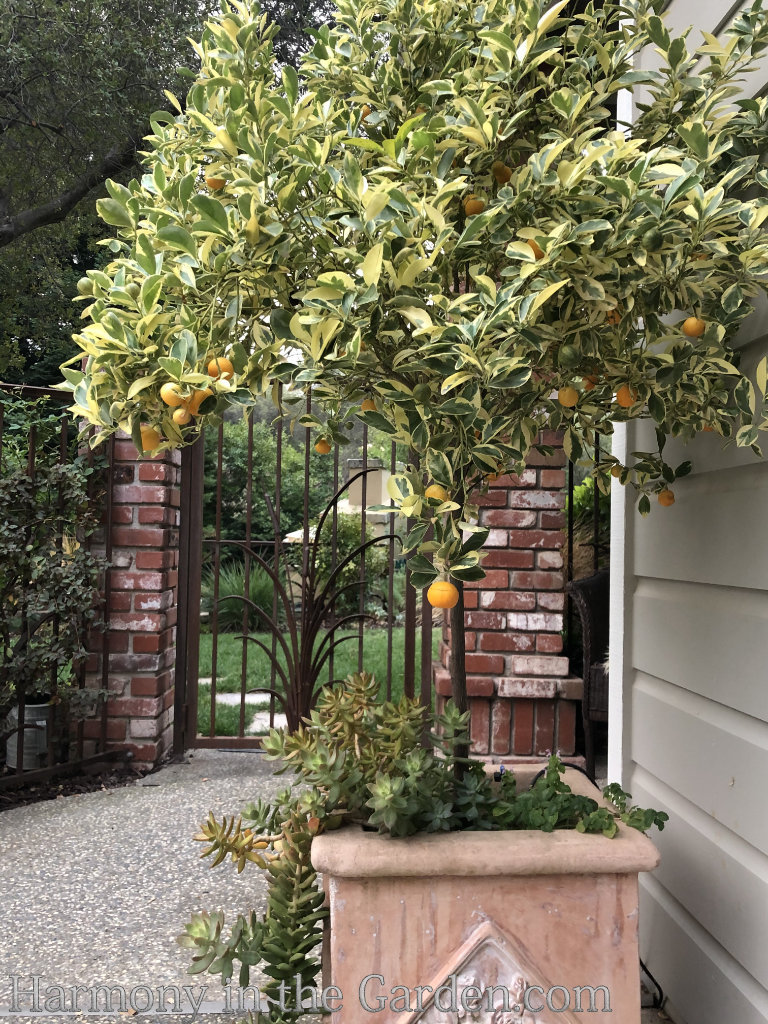
Feeding your hungry containers!
Plants that live in a tight space are naturally going to use up more nutrients than those planted in the ground.
They really do need to be fed quite often, with the general advice being once a month.
I prefer using an organic fertilizer, like this one (a little goes a LONG way with this product) or if you’re a little forgetful with feeding (like I am!), you can still have healthy plants by using a slow-release fertilizer, such as this one by Burpee.

Don’t forget the bling!
In addition to your underplantings, don’t forget to add a little bling to your container!
Just about anything counts, like this tumbled glass that I added to my succulent container.
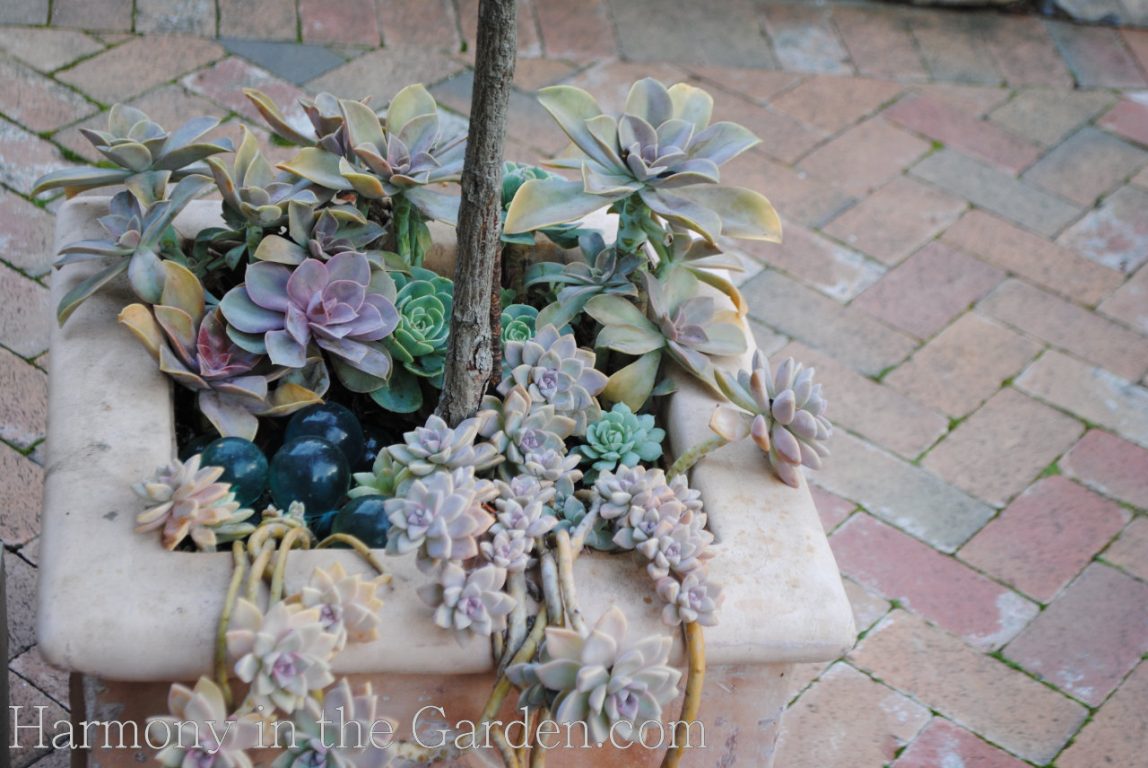
…or these glass balls discretely tucked in the base of this container.
Okay, this post is long enough – time to sign off now!
I hope I’ve given you some container inspiration and ideas on how to use them in your garden.

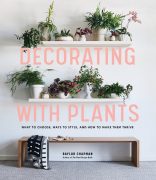




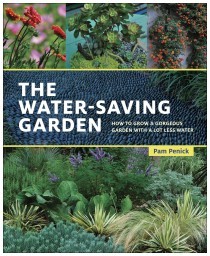
21 Comments
These are beautiful garden photographs! I love your blog, your helpful advice, but I just realized today, looking at these photos, that you are an amazing artist. Each photograph might well be a painting, with the garden as your canvas. It is remarkable, with your artist’s eye and your knowledge of plants and gardening, how you create living fine art. It is also wonderful that you are willing to share it. Thank you!
Carol, what a lovely thing to say! I’m so glad you’re enjoying my blog and photos. 🙂 I really do believe we’re all artists in our own way, whether it’s with traditional mediums, cooking, plants, or even working with computers (you should the magic my husband creates with his coding – ha!!) I hope your garden has fared well through the summer and that it’s nestling down now, getting ready for winter. Thank you, again, for making my morning. xoxoxo
Hello Rebecca,
Beautiful and inspirational container plantings! I have a question reg the patio planting (one rectangle planter on the ground, and another raised on legs, appears to be wrought iron). There is a large ivy growing in a wreath-like shape to the left of the photo. Is they ivy growing out of the raised planter? If so, how did you train it to grow in a circle? Is there a wire support underneath the ivy? Is it attached to the wall or somehow attached to the planter? Also, do you water by hand or use a drip irrigation system? I live in Folsom, so I know how very disciplined a gardener must be to water by hand…missing even one day in the summer =s dead plants!
Thanks for the kind words, Cheri! Yes, that one is wrought iron and the ivy is actually a topiary that I was given on my 30th birthday (many, many moons ago!) It’s a raised planter with several containers in it, the ivy being one of them. If I rely on myself to keep my pots watered, they’d be in a sad state for sure (especially with this heat!) so I have them hooked up to irrigation. I love the wire planter, as I can discreetly run a 1/4″ tube up the leg and into the pots. I’ll then sometimes place pots below the raised one, so they can take advantage of the extra water that runs through. Don’t want to waste a single drop! 🙂
What a clever idea! I see those ivy topiary plants at the garden center all the time! Planting the bottom of the iron planter is a great idea too! I see an iron planter going on my wish list… 🙂 Thanks for the info.
You’re so welcome!
Love all your pots, fell in love with your pomegranate in your Los Altos home, the color is wonderful. I am an addict for succulents in pots and always love to see your combinations., you have such a nice collection of pots.
Thanks so much, Susan! That pomegranate has been with me for years now – I wish more people could easily find them (I’ve yet to ever see one in the nursery since!) Succulents are certainly some of the most forgiving plants of all, aren’t they?
I enjoyed your post, you are so creative, you always inspire me. The garden is in full bloom here on Bainbridge Island–everything beautiful! Hope to see you soon.
Hi Gigi – Thanks so much! And WOW WOW WOW – your latest blog post and GORGEOUS paintings are amazing. You are so dang talented, my friend!!! Glad your garden is thriving – send more pics when you can! xoxoxo
As always wonderful and inspirational ideas. I always get great ideas including what to do with my adorable cement bunny with a too small for almost anything I could think of empty bag over his shoulder. Sedums will do it and cascade and look wonderful all year. I have lots of succulents but in the Northwest they would not all winter over–I an lucky to be able to put them inside my sun-room for the winter and rainy season. I especially enjoy your “findings” made into garden art. Keep up your wonderful work.
Thanks so much, Joan, and I’m so glad your bunny now has something to carry in his bag! There’s so many sedums out there, ‘Angelina’ is a favorite with its bright and fresh green color. You could tuck a teeny tiny easter egg in there, too. Send a pic when you’ve planted it – I’d love to see! 🙂
I was just sent your posting by a friend. Please add me to your email list. Thanks!!
Hi Gail – nice to ‘meet’ you, and I’m happy to add you to my blog list!
Thanks for an informative and beautiful article as usual. Like you, I use container gardens within my garden borders both planted and empty as focal Yours are gorgeous.
May I ask your source for your horizontal /rectangular containers. I have been searching
for them and am finding it difficult to find them. Yours are perfect size and color.
Thanks so much..
Hi Gay, thanks so much for the kind words. Oh, how I wish I had a great source for those containers! I bought those several years ago at Pottery Planet in Santa Cruz, CA. I loved the soft gray colors of them, too. Quality containers are so hard to find, aren’t they? A great source for breathtaking containers can also be found here https://www.eyeofthedaygdc.com/
Hello again, Gay – I wanted to let you know that I just returned from an outing to Pottery World (in Rocklin) and they had rectangular planters that were really similar to the one on my patio. Same size and thickness, only in a dark brown color that was actually really pretty. I’m not sure where you live, but thought I’d let you know!
Dear Rebecca, I am swooning over your lush containers. Each one combines interesting and sculpturally beautiful plant combos. You are as inspiring as your containers and gardens. Thank you!
Sheila, you’re always so sweet to me – what would I do without your HUGE words of encouragement! Thanks you, my friend. 🙂
Hi Rebecca! Great article. I completely agree with all your suggestions. I like to place containers in the planting areas and in key “sitting” areas as well. Always wonderful to see your inspiring work!
Take care, best always,
Sabrina and Freeland
Thanks so much, Sabrina, and have a beautiful weekend (is it cooler there? Thank HEAVENS it’s not so hot this weekend!!) xoxo